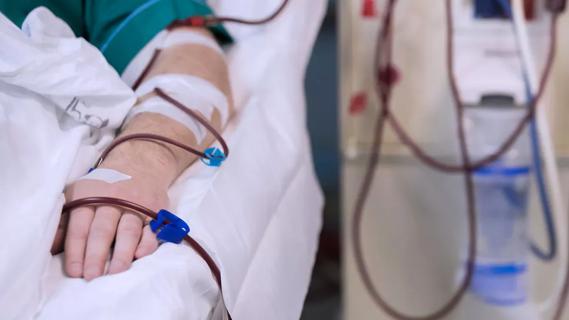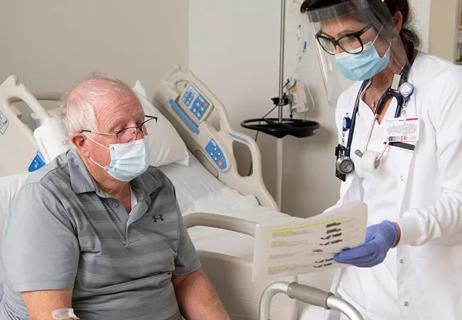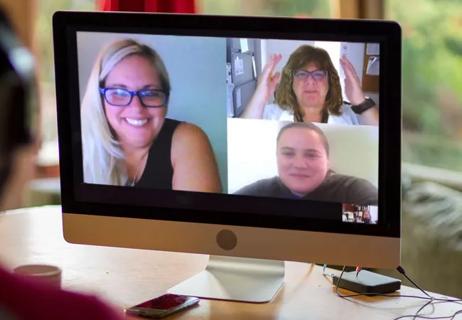Advertisement
Today’s model more strongly integrates all frontline nurses

In 2015, the Stanley Shalom Zielony Institute for Nursing Excellence set out to reengineer its shared governance model to ensure that frontline nurses across the system were more involved in shared governance practices and decision-making.
Advertisement
Cleveland Clinic is a non-profit academic medical center. Advertising on our site helps support our mission. We do not endorse non-Cleveland Clinic products or services. Policy
The change began when clinical nurses met with Executive Chief Nursing Officer K. Kelly Hancock, DNP, RN, NE-BC, following a “We Heard Your Voice” campaign. A workshop for the purpose of redesigning shared governance led to a model that more closely matches nursing practice expectations at the enterprise and unit levels.
The enhanced model includes:
The revised model places greater focus on clinical (direct care) nurses. Ideas and recommendations are generated at the unit level and flow inward through communication by council representatives who are empowered to act on issues.
Council decisions are communicated back to clinical nurses through nurse managers and unit council representatives. From hospital councils to enterprise system councils, two-way and multilevel communication flows to aide in the decision-making that promotes standardized practice.
The Zielony Nursing Institute’s shared governance structure focuses on the four quadrants of Cleveland Clinic’s Professional Practice Model:
Advertisement
During implementation of the enterprise revised model, nurses at each hospital had the freedom to adapt shared governance to meet local needs. Each hospital’s practice council used a shared governance model template that included the practice council as the outer ring of decision-making. Practice council members completed the inner rings to reflect decision-making specific to their hospital.
Each hospital is unique in scope of services and patient populations, and has its own culture. Variations in local shared governance models allows for focus on unique needs and priorities. For example, since some smaller hospitals do not have psychiatric, transplantation or newborn intensive care services, the discussions and decisions of the practice councils will vary.
Hospitals with fewer nursing units combine some councils to facilitate greater participation and faster time to meet goals. “Some hospitals cannot support having a large number of people away from nursing units at the same time,” explains Nancy DeWalt, BSN, RN, PCCN, NE-BC, Magnet Program Coordinator at Cleveland Clinic Hillcrest Hospital.
Every hospital has a nursing practice council, which is comprised of nurses from each unit that has a unit-based council. Many hospitals hold all of their shared governance activities on the same day each month so that nurse managers can adjust schedules to provide unit coverage for nurses who need time to prepare for and attend council meetings as part of their workweek.
At some hospitals, council meetings feature a global nursing congress in the morning that includes representatives from all councils, followed by individual unit council meetings in the afternoon. And every hospital has a nursing leadership structure that engages with the practice council in some way, the goal being to provide a mechanism for communication between the Nursing Executive Council and Shared Governance Practice council.
“We cast a wide net to reach nurses in all practice areas,” says DeWalt. “And the shared governance model schematic is displayed prominently in nursing units to keep it top of mind.”
Multihospital participation on Zielony Nursing Institute councils increases collaboration, raises ideas and solutions to unique situations, increases sharing of information, and helps nurses from different sites and in different work areas (such as ambulatory or cancer care) have a greater understanding of shared and discordant services and needs.
Advertisement
Both DeWalt and Karen Distelhorst, MSN, RN, GCNS-BC, a clinical nurse specialist at Cleveland Clinic South Pointe Hospital, stress that leaders attend meetings to answer questions and facilitate discussion, but formal nursing leaders do not vote on recommendations and actions. Council chairs and co-chairs are clinical nurses.
“I am very careful to help the group consider new ways of thinking, rather than offering my views,” says DeWalt. “It is more important that council members rally toward a best-solution that matches their perspectives. By facilitating solutions, nurses have immediate buy-in when they are ready to act.”
DeWalt cites many successful solutions initiated by clinical nurses. Hillcrest Hospital’s Quality and Safety Committee wrote a protocol that states that no member of the nursing staff should lift a patient alone. Since the protocol’s implementation, the hospital has seen a decrease in musculoskeletal injuries among nursing staff. As another example, the Healing Environment Council worked to teach nurses how to calm patients with reiki and musical therapy techniques.
Distelhorst believes Cleveland Clinic’s shared governance structure has been instrumental in promoting nurses’ professional practice and overall engagement. It has also been a strong component in helping hospitals apply for the American Nurses Credentialing Center’s Magnet Recognition Program®.
“In order to have Magnet Program recognition, you need to outperform the benchmark on nursing quality indicators and employee engagement. Shared Governance naturally improves both,” says Denise Griffin, RN, MSN/MBA, Magnet Program Manager at Cleveland Clinic South Pointe Hospital.
Council charters were designed so that nurses could define the purpose, goals and membership of each council in collaboration with nursing leadership. Leaders strive to appoint nurses to shared governance council in two-year terms (or longer).
Nurses may be asked to participate as a member in their first year, then as a co-chair of a council and then as a council chair. Escalation of roles within councils creates a clear succession plan and gives nurses time to learn and master skills for success, such as learning how to organize meetings, foster communication and interpret outcome metrics.
Advertisement
“Nurses can be very shy and uncertain when they start their shared governance rotation, but by the end of two years, they have confidence about their leadership role and are instrumental in moving agendas forward and communicating clinical nurse team views. It’s fun to watch,” explains Rosemary Field, MSN, OCN, a clinical nurse specialist at Cleveland Clinic Marymount Hospital.
Shared governance and decisional support by clinical nurses is a journey, with programs evolving as the environment changes. Being open to change is an important component of success, say several veteran nursing leaders.
South Pointe Hospital started its shared governance journey about 10 years ago and Marymount Hospital became part of it in 2010; by 2013 Marymount had started its own shared governance councils. When the two hospitals split governance, South Pointe’s nursing leaders chose to start from the ground up, studying best practices, conducting literature reviews and surveying nursing staff about what they wanted.
Cleveland Clinic main campus has had a shared governance structure since 2000, prior to its first Magnet® Recognition Program designation. Over the years, with changes in national and local healthcare environments and in professional nursing practice, the model was adapted to align with current and future needs of the Zielony Nursing Institute. One simple example is a greater emphasis on nursing innovation as a way to shape nursing practices. The original model did not include innovation, only nursing research.
“It is the agility of the program that gives it strength,” says DeWalt. “Our commitment to making shared governance a central part of nursing practice is what helps us to thrive.”
To drive home the importance of shared governance, the Zielony Nursing Institute hosts a Shared Governance Boot Camp event twice a year. Training focuses on methods of conducting a meeting, continuous improvement, decision-making domains, leadership and shared governance principles. When the new shared governance model was rolled out, more than 1,000 nurses attended the boot camp.
Advertisement
Advertisement

Clinicians prepare to deliver lifesaving care in the face of public health threats

Phone triage system reduces call backs and delays in care

New protocol reduces costs, increases patient and caregiver satisfaction

New options benefit caregivers, nursing units and patients

Nurses facilitate preoperative program to educate and prepare patients for ongoing care

Introduces at-home work and new patient screening tool

Health disparities, mental health and more

Ideas for approaches to prevention, response and more